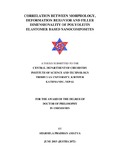Please use this identifier to cite or link to this item:
http://archive.nnl.gov.np:8080/handle/123456789/331| Title: | Correlation between morphology, deformation behavior and filler dimensionality of polyolefin elastomer based nanocomposites |
| Authors: | Pradhan Amatya, Sharmila |
| Keywords: | Ethylene/1-octene copolymer Morphology Deformation behavior Microhardness Nanocomposite FTIR spectroscopy X-ray diffraction Electron microscopy |
| Issue Date: | 25-Dec-2018 |
| Abstract: | This research has been aimed at designing nanocomposites of elastomeric ethylene/1-octene copolymer (EOC) with inclusion of nanofillers of different dimensionalities so as to investigate filler dimensionalities on morphology, deformation behavior, and thermal properties. The research has also been focused over determining the correlation between morphology and deformation behavior of the material. Besides, synthesizing the ionomer nanocomposite of EOC by chemical modification is also the secondary objectives. An elastomeric ethylene/1-octene copolymer (EOC) is blended with three different kinds of nanofillers by melt blending at 90 °C. The fillers used are multiwalled carbon nanotubes (MWCNT), layered silicate (LS) and boehmite, which represent 1D, 2D and 3D nanoparticles, respectively. Subsequently, the materials are characterized by different methods such as Fourier transform infrared (FTIR) spectroscopy, optical microscopy (OM), scanning electron microscopy (SEM), transmission electron microscopy (TEM), tensile test, microhardness measurement, hysteresis measurement, thermogravimetric analysis (TGA), and differential scanning calorimetry (DSC). Fourier transform infrared (FTIR) spectroscopic method reveals that the nanofillers are mixed physically with the polymer matrix as the IR peaks of nanocomposites are similar with that of the matrix polymer. The X-ray diffraction patterns of EOC and its nanocomposites appear at about same glancing angle which imply no change in d-spacing of the polymer and hence indicating no filler influence on the polymer crystal structure. Similarly, the degree of crystallinity of the matrix increase only insignificantly in presence of low filler fraction. Back scattered electron (BSE) imaging in the SEM of nanocomposites reveal that boehmite and LS filler are homogeneously distributed in the organic polymer matrix. Detail morphological analysis of the nanocomposites shows that the resulting nanocomposites develop mixed morphologies. The macroscoscopic mechanical test results indicate that the tensile properties are increased in the order of filler dimensionality: 1D>2D>3D. In the similar manner, the microhardness measurement revealed EOC nanocomposites reinforced with 1D and 2D filler are found to be stiffer compared to the materials containing 3D filler. Mechanical properties of the materials have further been studied via cyclic tensile deformation or hysteresis tests. From cyclic deformation test, residual strain of EOC/MWCNT nanocomposite is found to be higher compared to the rest of the samples attesting again that 1D filler is effective in reinforcing mechanical properties of the nanocomposite. The DSC results reveal that melting and crystallization temperatures are marginally changed with the addition of nanofillers. The crystallization temperature (Tc) of EOC/MWCNT nanocomposite is found to reduce slightly compared to the pure copolymer. The degree of crystallinity also remains practically unaffected by the presence of fillers. The TGA thermograms reveal that the nanocomposite materials have higher thermostability than the neat ethylene/1-octene copolymer. In an attempt to enhance the mechanical performance of the composites through chemical modification of the matrix polymer, an ionomer of EOC and its layered silicate nanocomposite have also been successfully prepared. The new composite materials have been characterized using FTIR, AFM and recording microindentation method. Microhardness measurement has revealed that the ionomer nanocomposites possess significantly improved hardness properties compared to the virgin polymer. |
| Description: | A thesis submitted to the Central Department of Chemistry, Institute of Science and Technology, Tribhuvan University, Nepal for the award of the degree of Doctor of Philosophy in Chemistry, 2015. |
| URI: | http://103.69.125.248:8080/xmlui/handle/123456789/331 |
| Appears in Collections: | 500 Natural sciences and mathematics |
Files in This Item:
| File | Description | Size | Format | |
|---|---|---|---|---|
| Sharmila Pradhan Amatya Ph. D Thesis, 2015.pdf | 5.18 MB | Adobe PDF |  View/Open |
Items in DSpace are protected by copyright, with all rights reserved, unless otherwise indicated.